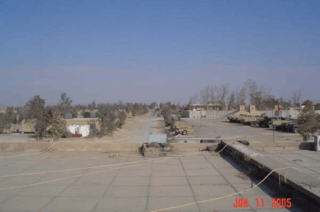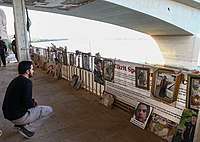Camp Speicher massacre
The Camp Speicher massacre occurred on 12 June 2014, when the Islamic State of Iraq and the Levant (ISIL) killed at least 1,600 to 1,700[2] non-Sunni militiamen and Iraqi Army cadets in an attack on Camp Speicher in Tikrit, Iraq. At the time of the attack, there were between 5,000 and 10,000 unarmed cadets in the camp,[3] and ISIL fighters selected the Shias and non-Muslims for execution.
| 2014 Speicher massacre | |
|---|---|
| Part of Northern Iraq offensive (June 2014), persecution of Shias by ISIL and Iraqi Civil War | |
 A picture of the area where the massacre occurred. | |
 Tikrit Camp Speicher massacre (Iraq) | |
| Location | Tikrit, Iraq |
| Coordinates | 34°36′36″N 43°40′48″E |
| Date | 12 June 2014 |
| Target | Shia militiamen and Iraqi Army cadets |
Attack type | Mass murder, terrorism |
| Deaths | 2000-2200[1][2] |
| Perpetrators | |
| Defender | |
The Iraqi government blamed the massacre on both ISIL and members of the Arab Socialist Ba'ath Party.[4]
Attack
Before the massacre, according to the Iraqi politician Mish'an al-Jubori, "Some of the chief officers of the camp ordered the cadets to have a rest for 15 days and to go to their families, with civilian clothes".[5] Several survivors later testified that their senior officers in the camp had forced them to leave the camp.[3][6]
While the cadets were walking on the highway looking for a bus to take them to Baghdad, two buses stopped near them with 10 armed men inside. One bus was driven by Ayman Sabawi Ibrahim, the son of Saddam Hussein's half brother, Sabawi Ibrahim al-Tikriti.[5] Several more buses with ISIL members arrived, and the cadets were kidnapped at gunpoint and taken to the Al-Qusour Al-Re'asiya region.[5]
Peter Bouckaert, the emergencies director for Human Rights Watch (HRW), stated: "The photos and satellite images from Tikrit provide strong evidence of a horrible war crime that needs further investigation. [ISIS] and other abusive forces should know that the eyes of Iraqis and the world are watching".[7] HRW also said that ISIL posted on its websites many videos and photographs showing how they beheaded and shot their victims while they celebrated.[7][8]
The photos show masked ISIL fighters tying up the cadets and loading them up on trucks, with other photographs showing ISIL fighters killing dozens of the cadets with assault rifles while they are lying down. ISIL propaganda videos show them shooting at hundreds of men lined up in mass graves in the desert. Some cadets faked their death, covering themselves with blood and escaping at night. Survivor Ali Hussein Kadhim told his story to The New York Times following his escape from the massacre.[9]
ISIL released footage of the massacre as part of their propaganda video Upon the Prophetic Methodology. The cadets are seen being crammed into trucks, some of them wearing civilian clothes to hide their military uniforms. Most of them are lying on the ground, with their jeans stripped to reveal camouflage uniforms underneath. Some of the prisoners were forced to defame Iraq's prime minister, Nouri al-Maliki, while others were forced to shout "long live the Islamic State". Some of them lined up as a cadet was beaten to death with a rifle. The killing methods varied, from shooting the cadets one by one to shooting them while lying down many times to ensure death.[7] Some cadets were shot and thrown into the Tigris river.
Aftermath

The Iraqi government claimed that 57 members of the Arab Socialist Ba'ath Party had taken part in the massacre.[10] Although pictures showed that every armed man was from ISIS, the government stated "Without any doubts and suspicion, all of these criminals are from the banned Ba'ath Party."[4] The minister of defense, Sa'dun al-Dulaimi, stated that the massacre was not sectarian in nature.[11] Although the spokesman of the Iraqi Armed Forces, Qasim Atta, stated that there were almost 11,000 cadets and soldiers missing from Camp Speicher; he also stated that thousands were executed in or near the presidential palaces, the al-Bu Agail region, and the Badoush prison by sectarian violence.[12]
On 2 September, more than 100 members of the families of the killed and missing cadets and soldiers broke into the Iraqi Parliament and hit three of the security guards.[13] After a day, a session started in the parliament with the attendance of representatives of the families and Sa'dun al-Dulaimi, along with other military officials to discuss the massacre.[14]
On 16 September, the Kurdish Asayish arrested four people suspected to be involved in the massacre in southern Kirkuk.[15] An unnamed security source stated, "The operation was executed by relying on intelligence information to arrest them."[16]
On 18 September, the Iraqi Human Rights ministry stated that as of 17 September, the total number of missing soldiers and cadets was 1,095,[17] denying the most popular figure of 1,700 soldiers having been killed. The ministry added, "The ministry relied in its statistics on spreading forms on the families of the missing people in Baghdad and the other governorate within its quest to document the crimes and violations that the terrorist group of the Islamic State is committing towards our people."[18] The Iraqi government ordered them to pay 10 million Iraqi dinar (equivalent to US$8,600) to the families of the missing cadets.[18]
Following the Iraqi forces' victory over ISIL in Tikrit in early April 2015, mass graves containing some of the murdered cadets were located and the decomposed corpses began to be exhumed.[19] Two of the alleged perpetrators of the massacre were arrested in Forssa, Finland, in December 2015. The suspects were identified from ISIL propaganda videos in which the executions of 11 men took place. Police did not disclose whether the men had made applications for asylum in Finland.[20] On 13 December 2016, the 24-year-old twins were charged with murder and committing a war crime for allegedly killing unarmed cadets, as well as "aggravated assault with terrorist aims".[21]
In August 2016, 36 men were executed by hanging for their part in the massacre.[22] On 6 September 2016, three mass graves were found by the Kata’ib al-Imam brigade containing the remains of over 30 people killed in the massacre.[23] In August 2017, 27 people were sentenced to death for the involvement in the massacre, and another 25 men were released because of the lack of evidence.[24]
References
- "Iraqi court sentences 24 to death over Speicher massacre". Middle East Monitor – The Latest from the Middle East. Archived from the original on 2 August 2015. Retrieved 6 August 2015.
- "احصائية رسمية: 1997 العدد الكلي لمفقودي مجزرتي سبايكر وبادوش". Rudaw. Retrieved 6 August 2015.
- "Survivors from the Speicher massacre: We were 4000 unarmed soldiers fell into the hands of ISIS". Buratha News Agency (in Arabic). Retrieved 13 September 2014.
- "ISIS, Saddam's men or a third party who killed 1700 soldiers in camp Speicher in Iraq?". CNN Arabic (in Arabic). Retrieved 13 September 2014.
- "Speicher massacre, cousins of Saddam started it and ISIL finished it". Al Wasat (in Arabic). Retrieved 13 September 2014.
- "Survivor from COB Speicher reveals details about the massacre". Al Alam (in Arabic). Retrieved 13 September 2014.
- "'ISIS commits mass murder, advertises it': Iraq executions detailed". Russia Today. Retrieved 13 September 2014.
- Saul, Heather (3 September 2014). "Iraqi soldier survives Isis mass execution by lying on floor - and pretending to be dead". The Independent. Retrieved 5 January 2020.
- Arango, Tim (3 September 2014). "Escaping Death in Northern Iraq". The New York Times. Retrieved 5 January 2020.
- "New Secrets are revealed about the Speicher massacre in Iraq". Al Fajr (in Arabic). Retrieved 13 September 2014.
- "Sa'dun al-Dulaimi says that the ones who committed the massacre weren't sectarians". Sout al-Iraq (in Arabic). Retrieved 13 September 2014.
- "Qassim Atta: 11,000 missing men from camp Speicher". Al Baghdadia (in Arabic). Archived from the original on 13 September 2014. Retrieved 13 September 2014.
- "The families of the missing people of camp Speicher break into the parliament". Al Jazeera (in Arabic). Retrieved 13 September 2014.
- "An emergency parliament session to discuss the Speicher massacre". Al Jazeera (in Arabic). Retrieved 13 September 2014.
- "4 suspected in the massacre of Speicher are arrested". Kitabat (in Arabic). Archived from the original on 9 June 2015. Retrieved 19 September 2014.
- "Arresting 4 suspected to be involved in the crime of Speicher in southern Kirkuk". Al Sumaria (in Arabic). Retrieved 19 September 2014.
- "1095 soldiers still missing since the Speicher massacre by ISIS". CNN Arabic (in Arabic). Retrieved 19 September 2014.
- "Ministry of Human Rights: The number of the missing people of Camp Speicher reached 1095". Al Sumaria (in Arabic). Retrieved 19 September 2014.
- Ellis, Ralph (6 April 2015). "New mass graves found in Tikrit". CNN. Retrieved 6 April 2015.
- "Two detained in Finland over ISIS executions in Tikrit". 10 December 2015. Retrieved 10 December 2015.
- "Finland tries twins over IS massacre in Iraq". Yahoo News. Retrieved 5 January 2020.
- "Iraq hangs 36 men for Camp Speicher massacre". BBC News. Retrieved 21 August 2016.
- "3 mass graves discovered in central Tikrit". Iraqi News. Retrieved 6 September 2016.
- "Iraq to hang 27 for IS Camp Speicher massacre". BBC News. Retrieved 8 August 2017.